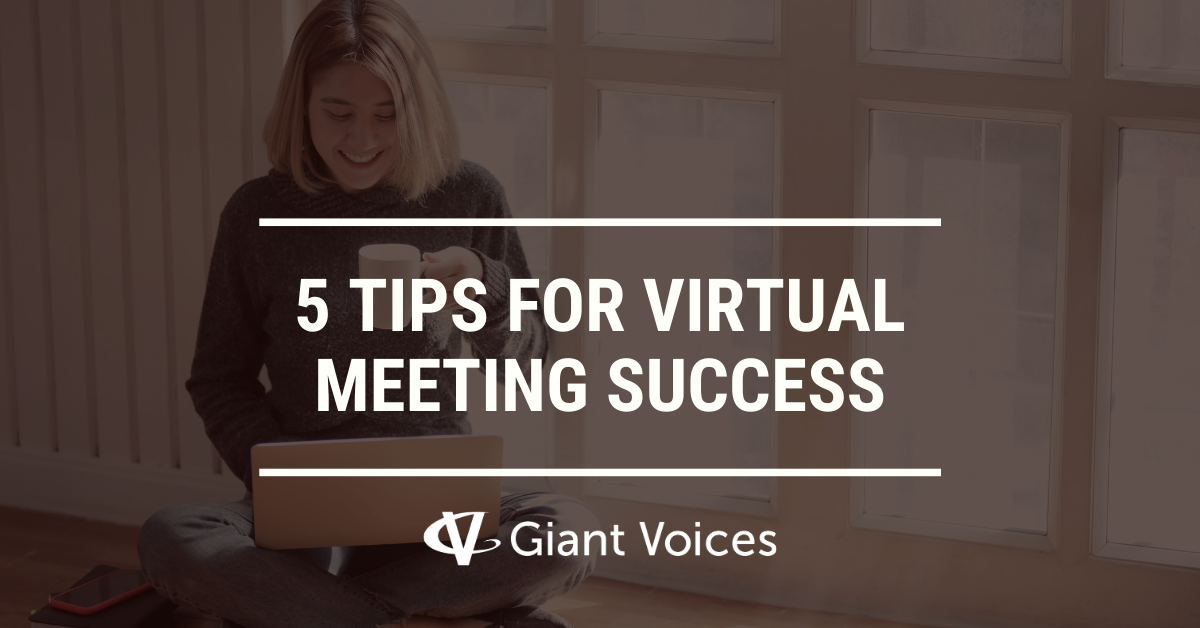Five Tips for Virtual Meeting Success

Virtual meetings have become an essential part of our new normal. Seasoned remote workers are no strangers to virtual meetings, but for those of us who are used to face-to-face human interactions, deriving the same value from a virtual meeting (not to mention staying focused) can be more challenging than it seems.
For the foreseeable future, virtual meetings are the best or only option to collaborate. Use these five tips to avoid common pitfalls and make each meeting as productive as possible.

Stay on Track – Keep Virtual Meetings Running Smoothly
When you’re sitting in a conference room, it’s easy to see who’s in charge, but when you’re meeting online, it’s not quite so clear—especially if you’re collaborating across several companies or teams. Know that if you called the meeting, you’re likely in charge—and that comes with extra responsibilities.
First, create and share an agenda at least 24 hours before the meeting. When you’re meeting in person, it’s easier to pivot on the fly, but virtual meetings need a little more structure.
If you have specific requests or expectations, make those clear when you share the agenda. This gives attendees ample time to review and prepare. Having a clear outline of what you want to accomplish and sticking to it during the time allotted will help you ensure your meeting is productive.
Next, keep an eye on the clock—these meetings go fast. If it helps, designate a timekeeper who will help you keep the meeting progressing smoothly.
It is also important to watch out for tangents that could take your meeting off track—but be sure to table valuable but off-agenda topics for follow up or future meetings.
Be Courteous – We’re All in This Together
The first rule of virtual meetings is: do not talk unless it is your turn to speak. Try not to speak over your colleagues, and be sure to mute your microphone when you’re not talking.
Remote work environments often come with potential distractions that can cause unintentional background noise, so it’s best to remain on mute until the conversation steers your way.
If you can’t talk and you can’t interrupt your coworkers, how can you get a word in edgewise? There are a few polite options. Capture the meeting facilitator’s attention with a hand wave and wait until you’re invited to speak.
Or, wait for a pause in the conversation and jump in. You can also chat in most platforms—note you have something to add, and then wait for others to stop speaking or the meeting facilitator to call on you.
When everyone practices general etiquette, the entire meeting will run more smoothly. Everyone will get a chance to add their input without stepping on others’ toes in the process.
Be Attentive to Minimize Distractions
Working from home often comes with multitasking—especially when you’re working from home during a pandemic. You’re likely sharing space with a spouse, partner or roommate, and you may have kids at home needing supervision (not to mention education) or pets that crave attention.
That’s enough distraction for anyone. Your team surely understands and is likely in a similar boat, but it’s best to minimize distractions during a virtual meeting whenever possible.
Try to retreat to a separate space for the duration of the call. Otherwise, do your best to keep your wards entertained while still actively participating in the meeting.
You’ll also have to battle the rest of your work responsibilities simultaneously. Avoid checking your email or your phone during the meeting. Silence all notifications and focus on the conversation.
One last tip: keep your eyes on whoever is speaking rather than watching yourself in the camera—it’ll help you stay engaged, and you’ll avoid missing valuable information, requests to speak or questions aimed at you. Don’t worry about your hair or the bad camera angle!
Lights, Camera, Action – Get Comfortable with Your Camera
We know we just told you not to look at yourself in the camera, which is why it is smart to do a quick video test before you join the meeting.
Make sure your camera has a clean lens, so your video feed is crisp and clear. If your job requires you to meet with high-profile clients, it may be worth investing in a high-resolution camera to ensure excellent video quality at every meeting.
Most people don’t love being on camera, but it’s a necessary element of modern business. These tips should help you feel more comfortable being in front of the camera regularly.
First, find a location with a clear backdrop. A plain wall or a spot with minimal décor is best. Try not to sit with a window behind you as the backlighting will make you appear dark.
Next, center the camera. Position head-on, from your shoulders and up, in the middle of the screen. It can be distracting to other attendees if they can only see part of your face or if you’re looking off to the side when people are talking.
Lastly, remember to sit up straight and look into the camera when you speak. Resist the temptation to look at yourself in the camera, instead address your fellow attendees just like you would during an in-person meeting.
Conclude Effectively
There is no shortage of new memes about the awkwardness of virtual meeting conclusions. The long goodbyes. The strange pauses as attendees look for the red button that’ll allow them to hang up. The lingering silent faces.
Avoid all this by having a strong wrap-up.
Provide a quick recap of what you covered during the meeting and any action items left on the table. Ask if anyone has any final questions. Outline any deliverables that arose during the meeting and the necessary next steps to keep the project moving forward. Announce the time for the next meeting or any expected follow-up calls or emails, and lastly, thank attendees for their participation. Then it’s time to click END.
Adding in this transition period will signal that the meeting is concluding while allowing attendees to make any last-minute notes, ask final questions and prepare to sign off.